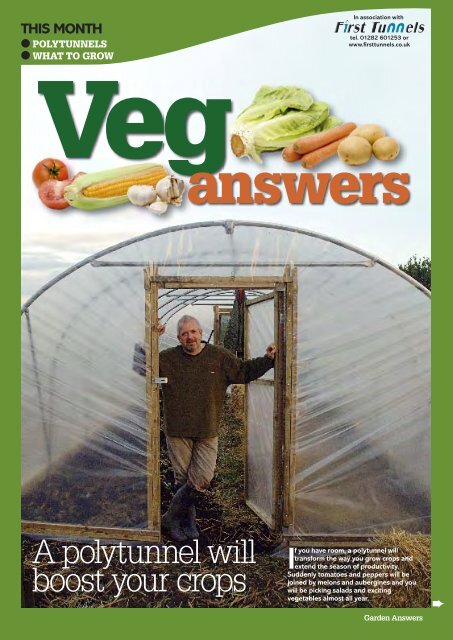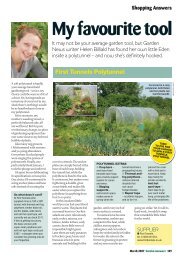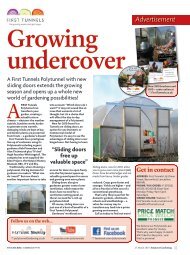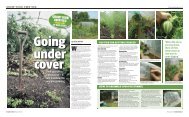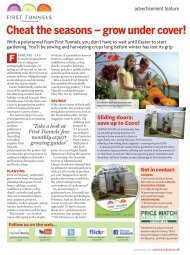Veg eg
You also want an ePaper? Increase the reach of your titles
YUMPU automatically turns print PDFs into web optimized ePapers that Google loves.
THIS MONTH<br />
● POLYTUNNELS<br />
● WHAT TO GROW<br />
In association with<br />
tel. 01282 601253 or<br />
www.firsttunnels.co.uk<br />
<strong>V<strong>eg</strong></strong><br />
<strong>eg</strong><br />
answers<br />
A polytunnel will<br />
boost your crops<br />
If you have room, a polytunnel will<br />
transform the way you grow crops and<br />
extend the season of productivity.<br />
Suddenly tomatoes and peppers will be<br />
joined by melons and aubergines and you<br />
will be picking salads and exciting<br />
v<strong>eg</strong>etables almost all year.<br />
Garden Answers
In association with<br />
<strong>V<strong>eg</strong></strong><br />
g<br />
answers<br />
tel. 01282 601253 or www.firsttunnels.co.uk<br />
P<br />
Polytunnels are sometimes r<strong>eg</strong>arded<br />
as nothing more than a cheap<br />
greenhouse but they are a useful<br />
garden addition in their own right. It is a<br />
curious fact that some plants seem to grow<br />
better under plastic than under glass and<br />
the atmosphere is very different. In general<br />
it is more humid and, unless you buy one<br />
with vents, it can be hot in summer and is<br />
always cold in winter.<br />
Before buying, there are some important<br />
considerations. First, it is sensible to buy as<br />
large a polytunnel as you can afford and<br />
accommodate – you will always fi nd plenty<br />
to grow in it. This applies to width as well<br />
as length. You will have at least one door –<br />
preferably one at each end, so you get<br />
some ventilation – and you will need a path<br />
through the centre which will take up about<br />
45cm (18in) minimum width. So a wider<br />
polytunnel will be more effi cient. Consider<br />
the side curves – those with straighter,<br />
more upright sides will be easier to work in<br />
without stooping and you will be able to<br />
It is vital to get the frame measured out accurately<br />
grow taller plants right up to the edge.<br />
The most annoying thing about<br />
polytunnels is having to re-skin them. Even<br />
UV stabilised polythene skins deteriorate<br />
over time and get brittle, less transparent or<br />
ripped. So always buy the best quality you<br />
can when ordering – thin, cheap polythene<br />
is a bad investment.<br />
There are two main ways to hold the skin<br />
in place. The simplest is to dig a trench<br />
around the frame and tuck the edge of the<br />
polythene in that, cover with soil and trim<br />
the sheet. This can hold the skin tight but<br />
you must allow room around the structure,<br />
not only to do this, but to dig it out and<br />
replace the polythene every three years or<br />
so. The other way is to fi t a wooden frame<br />
around the base, just above soil level and<br />
attach the skin with battens. It looks neater<br />
and may be easier to reskin – at least it will<br />
be less messy. My current tunnel from First<br />
Tunnels has its skin fi xed in this way.<br />
There are two main ways the frame is<br />
held in place. Mine has brackets that are<br />
screwed into place in holes that were dug<br />
and then refi lled, making a very secure<br />
base. The more traditional way is to ‘bang’<br />
tubes in the ground and slide the tunnel<br />
frame into these sleeves – the polythene<br />
cover holds the whole structure down<br />
when it is buried around the edge.<br />
Ideally, the tunnel should be erected and<br />
skinned on a warm day, not only so you can<br />
handle the metal parts with more comfort<br />
but also because the polythene cover will<br />
be more ‘stretchy’ and easier to tension,<br />
but this is not essential and my latest went<br />
up on a chilly November day two years<br />
ago! But try not to pick a windy day – 15m<br />
(50ft) of polythene fl apping in the breeze<br />
is not as much fun as it sounds.<br />
You will need some form of irrigation in<br />
the polytunnel and a sprinkler system or<br />
seep hoses will certainly make life easier.<br />
Then you should improve the soil, as with<br />
any v<strong>eg</strong> growing, adding as much organic<br />
matter as possible. After all that, you can<br />
get growing.<br />
ERECTING MY 30FT POLYTUNNEL ON THE ALLOTMENT<br />
Straw bales made handy steps and were later used as mulch<br />
You will need a hand to put the cover on<br />
By the end of a long day, the polytunnel was complete<br />
Enjoy salads almost all year round<br />
WHAT TO GROW<br />
The list of crops you can grow in your<br />
polytunnel is extensive. Most usefully<br />
you can extend the season significantly<br />
so early crops of salads are possible<br />
and you can sow winter salads like<br />
winter lettuce and lamb’s lettuce.<br />
Endives and chicories can be harvested<br />
well into winter and oriental v<strong>eg</strong> will<br />
flourish into autumn too. I always grow<br />
a few early potatoes too – mainly<br />
salad potatoes – but the main benefit<br />
is the extra warmth in summer that<br />
allows tomatoes, aubergines, peppers<br />
and cape gooseberries to thrive.<br />
Last year the advantage of growing<br />
tomatoes in the polytunnel was clear<br />
because they did not succumb to blight<br />
as plants outside did. In fact, I have to<br />
confess that growing tomatoes was the<br />
main reason why I put up the<br />
polytunnel in the first place. I grow a<br />
wide variety of types and they all thrive<br />
under plastic. By choosing some small,<br />
baby plum types such as ‘Santa’ I was<br />
able to pick my first ripe tomatoes in<br />
early July. I tend to favour the large<br />
beefsteak kinds and these are much<br />
more reliable in here than outside.<br />
Because you will have soil rather than<br />
paving (I spread straw around liberally<br />
for the path and to mulch, despite the<br />
way it attracts slugs) you can easily<br />
plant between the tomatoes or allow<br />
wider spacing for bush tomatoes that<br />
sprawl along the ground. But by<br />
keeping the plants dry and avoiding<br />
rain splash, the fruits of these lowgrowers<br />
will be kept clean. I sow rows<br />
Pull tasty radishes in April<br />
of French beans and plant the<br />
tomatoes between these and they crop<br />
before the tomatoes get too big.<br />
Melons, cucumbers and watermelons<br />
also produce good crops and any<br />
spare gaps I fill with salad leaves,<br />
herbs and radishes throughout the<br />
summer.<br />
The latest addition in my own tunnel<br />
has been a peach and a nectarine.<br />
I have grown these before in a tunnel<br />
and they have done brilliantly. The<br />
advantage of growing them in a<br />
polytunnel is that you can keep the<br />
foliage dry, which will usually prevent<br />
any problems with peach leaf curl, the<br />
most serious disease of these two<br />
crops and the polytunnel will protect<br />
the flowers from frost in most cases.<br />
However, you will need to handpollinate<br />
the flowers because early<br />
bees may not be able to find them. The<br />
other advantage is that, even in wet<br />
summer, you can be sure your fruits<br />
will ripen and you can try almost any<br />
variety you want, not just the early<br />
varieties that may seem the sensible<br />
option in your area.<br />
If you have room, or the inclination,<br />
you could easily produce an early crop<br />
of strawberries or a late crop of<br />
perpetual strawberries and there is<br />
even the possibility of growing<br />
Early ‘Roseval’ potatoes from<br />
the tunnel last year<br />
autumn-fruiting raspberries too, either<br />
in a cold area where they may not<br />
normally thrive or simply to extend the<br />
season.<br />
A polytunnel really is worth every<br />
penny if you grow your own v<strong>eg</strong>.<br />
Garden Answers<br />
Garden Answers


